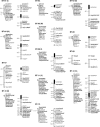A linkage map for brown trout (Salmo trutta): chromosome homeologies and comparative genome organization with other salmonid fish
- PMID: 16452148
- PMCID: PMC1456399
- DOI: 10.1534/genetics.105.048330
A linkage map for brown trout (Salmo trutta): chromosome homeologies and comparative genome organization with other salmonid fish
Abstract
We report on the construction of a linkage map for brown trout (Salmo trutta) and its comparison with those of other tetraploid-derivative fish in the family Salmonidae, including Atlantic salmon (Salmo salar), rainbow trout (Oncorhynchus mykiss), and Arctic char (Salvelinus alpinus). Overall, we identified 37 linkage groups (2n = 80) from the analysis of 288 microsatellite polymorphisms, 13 allozyme markers, and phenotypic sex in four backcross families. Additionally, we used gene-centromere analysis to approximate the position of the centromere for 20 linkage groups and thus relate linkage arrangements to the physical morphology of chromosomes. Sex-specific maps derived from multiple parents were estimated to cover 346.4 and 912.5 cM of the male and female genomes, respectively. As previously observed in other salmonids, recombination rates showed large sex differences (average female-to-male ratio was 6.4), with male crossovers generally localized toward the distal end of linkage groups. Putative homeologous regions inherited from the salmonid tetraploid ancestor were identified for 10 pairs of linkage groups, including five chromosomes showing evidence of residual tetrasomy (pseudolinkage). Map alignments with orthologous regions in Atlantic salmon, rainbow trout, and Arctic char also revealed extensive conservation of syntenic blocks across species, which was generally consistent with chromosome divergence through Robertsonian translocations.
Figures






References
-
- Allendorf, F. W., and G. H. Thorgaard, 1984. Tetraploidy and the evolution of salmonid fishes, pp. 1–46 in Evolutionary Genetics of Fishes, edited by B. J. Turner. Plenum Press, New York.
-
- Allendorf, F. W., F. M. Utter and B. P. May, 1975. Gene duplication within the family Salmonidae: detection and determination of the genetic control of duplicate loci through inheritance studies and examination of populations, pp. 415–431 in Isozymes, Vol. IV: Genetics and Evolution, edited by C. L. Markert. Academic Press, New York.
-
- Allendorf, F. W., J. E. Seeb, K. L. Knudsen, G. H. Thorgaard and R. F. Leary, 1986. Gene-centromere mapping of 25 loci in rainbow trout. J. Hered. 77: 307–312.
Publication types
MeSH terms
LinkOut - more resources
Full Text Sources
Research Materials

